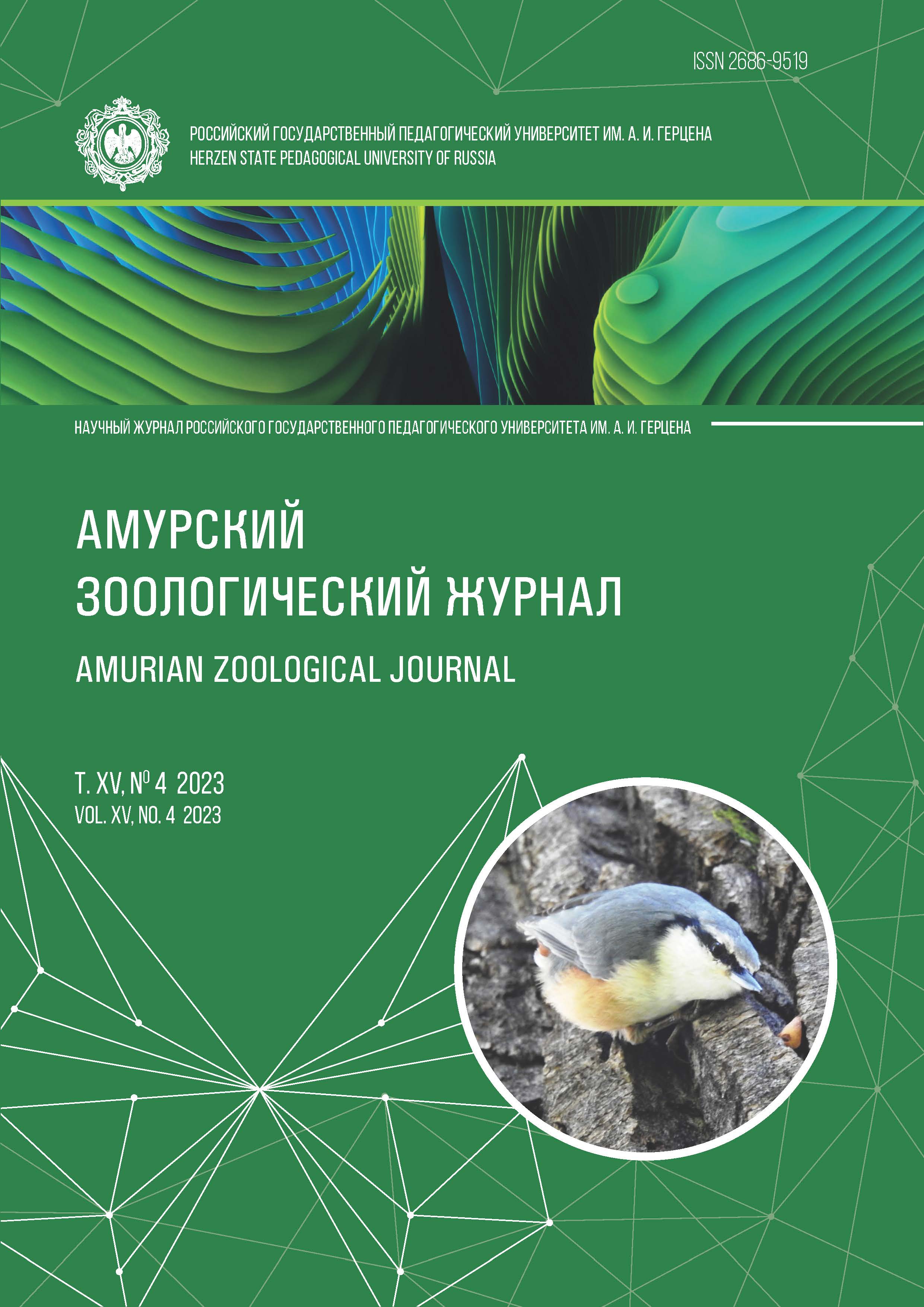Development dynamics of Kavkaz-2 and Sovetskaya-14 NGL silkworm caterpillars on artificial nutrient medium IPS 7.2-G
DOI:
https://doi.org/10.33910/2686-9519-2023-15-4-870-880Keywords:
silkworm (Bombyx mori), artificial nutrient medium, development dynamics, caterpillar age, caterpillar live weight, caterpillar lengthAbstract
Silkworm, bred mainly for the production of cocoons (raw materials for the textile industry), has recently become a biological model for research in various fields of science as well as a source of biologically active substances. These applications, however, have certain limitations. Among them are the seasonality of sericulture and the dependence of caterpillar cultivation on its main feed — fresh mulberry leaves. This article discusses the results of feeding two highly productive breeds of silkworm — Kavkaz-2 and Sovetskaya-14 NGL — on an artificial nutrient medium (IPS 7.2-G). The nutrient medium was developed by the team of authors. It is intended for year-round cultivation of silkworm in laboratory conditions to further use it in various experiments or as biomass. With the feeding period of 36 days, the Kavkaz-2 breed showed the highest development dynamics on an artificial diet, followed by the Sovetskaya-14 breed with the feeding period of 43 days. In terms of biomass growth, however, Sovetskaya-14 exceeds Kavkaz-2 by 8.2%.
References
Bhattacharyya, P., Jha, S., Mandal, P., Ghosh, A. (2016) Artificial diet based silkworm rearing system-A review. International Journal of Pure & Applied Bioscience, vol. 4, no. 6, pp. 114–122. https://doi.org/10.18782/2320-7051.2402 (In English)
Guncheva, R., Tsenov, P. Vasileva, Y. (2021) Productivity of newly created F1 tetrahybrids of the silkworm Bombyx mori L. reared with artificial diet low in mulberry powder. Bulgarian Journal of Agricultural Science, vol. 27, no. 6, pp. 1221–1226. (In English)
Li, J., Deng, J., Deng, X. et al (2023) Metabonomic analysis of silkworm midgut reveals differences between the physiological effects of an artificial and mulberry leaf diet. Insects, vol. 14, no. 4, article 347. https://doi.org/10.3390/insects14040347 (In English)
Matsumoto, Y., Sekimizu, K. (2019) Silkworm as an experimental animal for research on fungal infections. Microbiology and Immunology, vol. 63, no. 2, pp. 41–50. https://doi.org/10.1111/1348-0421.12668 (In English)
Moise, A. R., Pop, L. L., Vezeteu, T. V. et al. (2020) Artificial diet of silkworms (bombyx mori) improved with bee pollen – biotechnological approach in global centre of excellence for advanced research in sericulture and promotion of silk production. Bulletin University of Agricultural Sciences and Veterinary Medicine Cluj-Napoca. Animal Science and Biotechnologies, vol. 77, no. 1, pp. 51–57. https://doi.org/10.15835/buasvmcnasb:0004.20 (In English)
Montali, A., Berini, F., Brivio, M. F. et al. (2020) A silkworm infection model for in vivo study of glycopeptide antibiotics. Antibiotic, vol. 9, no. 6, article 300. https://doi.org/10.3390/antibiotics9060300 (In English)
Nikolova, T. (2020) Growing mulberry silkworm with аrtificial diet with added extract Tribulus terrestris L. Bulgarian Journal of Agricultural Science, vol. 26 no. 5, pp. 1041–1046. (In English)
Nouara, A., Lu, P., Chen, K. (2018) Silkworm, Bombyx mori, as an alternative model organism in toxicological research. Environmental Science and Pollution Research, vol. 25, pp. 35048–35054. https://doi.org/10.1007/s11356-018-3442-8 (In English)
Panthee, S., Paudel, A., Hamamoto, H., Sekimizu, K. (2017) Advantages of the silkworm as an animal model for developing novel antimicrobial agents. Frontiers in Microbiology, vol. 8, article 373. https://doi.org/10.3389/fmicb.2017.00373 (In English)
Paudel, A., Panthee, S., Hamamoto, H., Sekimizu, K. (2020) A simple artificial diet available for research of silkworm disease models. Drug Discoveries and Therapeutics, vol. 14, no. 4, pp. 177–180. https://doi.org/10.5582/ddt.2020.03061 (In English)
Thamidela, M. D., Bagde, A. S., Hole, U. D., Jadhav, P.S. (2021) Effect of natural and artificial diets on growth parameters of kolar gold, silkworm. International Journal of Current Microbiology and Applied Sciences, vol. 10, no. 3, pp. 1725–1732. (In English)
Wu, X., Chen, X., Ye, A. et al. (2022) Multitissue metabolomic profiling reveals potential mechanisms of cocoon yield in silkworms (Bombyx mori) fed formula feed versus mulberry leaves. Frontiers Molecular Biosciences, vol. 9, article 977047. https://doi.org/10.3389/fmolb.2022.977047 (In English)
Xu, M., Zhu, F., Chen, K. (2017) Silkworm: A promising model organism in life science. Journal of Insect Science, vol. 17, no. 5, article 97. https://pubmed.ncbi.nlm.nih.gov/29117372 (In English)
Downloads
Published
Issue
Section
License
Copyright (c) 2023 Viktor G. Evlagin, Elena G. Evlagina, Evdokia F. Leinweber, Evgeny N. Yumatov

This work is licensed under a Creative Commons Attribution-NonCommercial 4.0 International License.
The work is provided under the terms of the Public Offer and of Creative Commons public license Creative Commons Attribution 4.0 International (CC BY 4.0).
This license permits an unlimited number of users to copy and redistribute the material in any medium or format, and to remix, transform, and build upon the material for any purpose, including commercial use.
This license retains copyright for the authors but allows others to freely distribute, use, and adapt the work, on the mandatory condition that appropriate credit is given. Users must provide a correct link to the original publication in our journal, cite the authors' names, and indicate if any changes were made.
Copyright remains with the authors. The CC BY 4.0 license does not transfer rights to third parties but rather grants users prior permission for use, provided the attribution condition is met. Any use of the work will be governed by the terms of this license.







